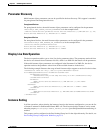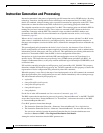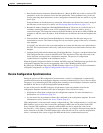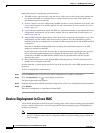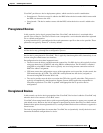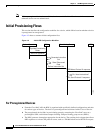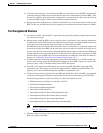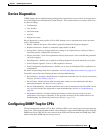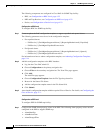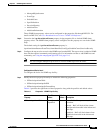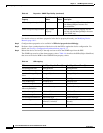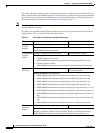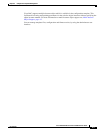
4-21
Cisco Broadband Access Center 3.8 Administrator Guide
OL-27172-01
Chapter 4 CPE Management Overview
Device Diagnostics
Device Diagnostics
CWMP supports device troubleshooting and diagnostics features that you use to focus on a single device
and collect diagnostics information for further analysis. This feature enables you to query devices for
any data, including:
• Configuration
• Live statistics
• Fault indications
• Log file
• Diagnostics results
Device diagnostics is made possible in Cisco BAC through a set of operations that can be run on the
device. These include:
• Reboot—Reboots the device. This reboot is primarily intended for diagnostic purposes.
• Request Connection—Initiates a connection request with Cisco BAC.
• Factory Reset—Resets a preregistered device settings to its original factory settings, to before a
subscriber-specific configuration was burnt in.
• Display Live Data—Views device parameters directly from a device. You can define the parameters
you want to appear.
• Ping Diagnostic—Enables you to perform an IP ping diagnostics test from the device to any host.
• Force Firmware Upgrade—Forces a CPE to update its firmware.
• Force Configuration Synchronization—Enables you to force an individual CPE to synchronize its
configuration.
For details on performing these device operations, see Performing Operations on Devices, page 16-14.
Cisco BAC also provides the following features to help troubleshooting:
• Device History—Provides a detailed history of significant events that occur in a device provisioning
lifecycle. See Device History, page 8-1.
• Device Faults—Detects devices with recurring faults, which can cause bottlenecks and affect
network performance. See Device Faults, page 8-6.
• Device Troubleshooting—Provides detailed records of device interactions with Cisco BAC servers
for a set of devices that are designated for such troubleshooting. See Device Troubleshooting,
page 8-9.
• Performance Statistics—Provides detailed performance statistics that are related to system
performance across major components. It also provides an analysis of the statistical data to aid
troubleshooting. See Monitoring Performance Statistics, page 11-14.
Configuring SNMP Trap for CPEs
The fault management module of Cisco BAC facilitates CPEs to raise alarms and send events when any
fault occurs. The fault management module can be enhanced to support the SNMP trap facility. With the
SNMP trap facility, DPE receives the events from the CPEs and converts them into SNMP traps. DPE
further sends these SNMP traps to the trap receiver.



